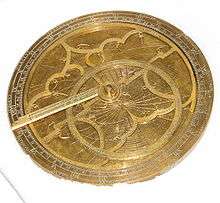Astrolabe



An astrolabe (Greek: ἀστρολάβος astrolabos, "star-taker")[1] is an elaborate inclinometer, historically used by astronomers and navigators, to measure the inclined position in the sky of a celestial body, day or night. It can thus be used to identify stars or planets, to determine local latitude given local time and vice versa, to survey, or to triangulate. It was used in classical antiquity, the Islamic Golden Age,[2] the European Middle Ages and the Renaissance for all these purposes.
While the astrolabe is effective for determining latitude on land or calm seas, it is less reliable on the heaving deck of a ship in rough seas. The mariner's astrolabe was developed to solve that problem.
Etymology
OED gives the translation "star-taker" for the English word "astrolabe" and traces it, through medieval Latin, to the Greek word astrolabos[1][3] from astron "star" and lambanein "to take".[4] In the medieval Islamic world the word "asturlab" (i.e. astrolabe) was given various etymologies. In Arabic texts, the word is translated as "akhdh al-kawakib" (lit. "taking the stars") which corresponds to an interpretation of the Greek word.[5] Al-Biruni quotes and criticizes the medieval scientist Hamzah al-Isfahani who had stated:[5] "asturlab is an arabization of this Persian phrase" (sitara yab, meaning "taker of the stars").[6] In medieval Islamic sources, there is also a "fictional" and popular etymology of the words as "lines of lab". In this popular etymology, "Lab" is a certain son of Idris (=Enoch). This etymology is mentioned by a 10th-century scientist named al-Qummi but rejected by al-Khwarizmi.[7] "Lab" in Arabic also means "sun" and "black stony places" (cf. Dictionary).
History
Ancient world
An early astrolabe was invented in the Hellenistic world by Apollonius of Perga, around 220 BCE or in 150 BC and is often attributed to Hipparchus. A marriage of the planisphere and dioptra, the astrolabe was effectively an analog calculator capable of working out several different kinds of problems in spherical astronomy. Theon of Alexandria (c. 335 – c. 405) wrote a detailed treatise on the astrolabe, and Lewis[8] argues that Ptolemy used an astrolabe to make the astronomical observations recorded in the Tetrabiblos.[lower-alpha 1] It is generally accepted that Greek astrologers, in either the first or second centuries BC, invented the astrolabe, an instrument that measures the altitude of stars and planets above the horizon. Some historians erroneously attribute its invention to Hypatia, the daughter of the mathematician Theon of Alexandria,[11] and others note that Synesius, a student of Hypatia, credits her for the invention in his letters.[9]
Astrolabes continued in use in the Greek-speaking world throughout the Byzantine period. About 550 AD the Christian philosopher John Philoponus wrote a treatise on the astrolabe in Greek, which is the earliest extant Greek treatise on the instrument.[lower-alpha 2] In addition, Severus Sebokht, a bishop who lived in Mesopotamia, also wrote a treatise on the astrolabe in Syriac in the mid-7th century.[lower-alpha 3] Severus Sebokht refers in the introduction of his treatise to the astrolabe as being made of brass, indicating that metal astrolabes were known in the Christian East well before they were developed in the Islamic world or the Latin West.[12]
Medieval era
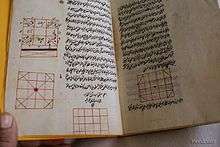
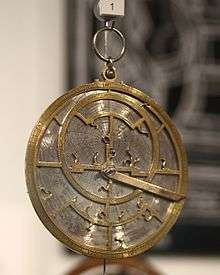
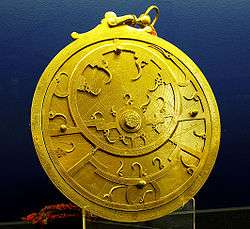
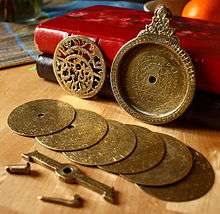
.jpg)
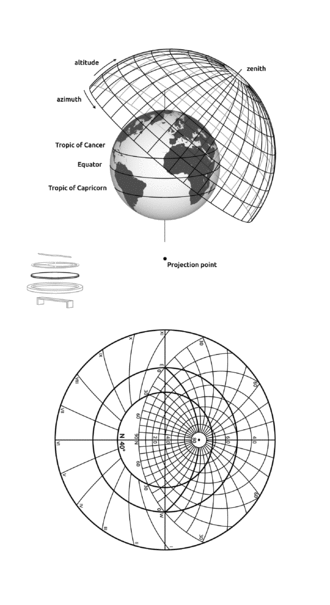
Astrolabes were further developed in the medieval Islamic world, where Muslim astronomers introduced angular scales to the astrolabe,[13] adding circles indicating azimuths on the horizon.[14] It was widely used throughout the Muslim world, chiefly as an aid to navigation and as a way of finding the Qibla, the direction of Mecca. The first person credited with building the astrolabe in the Islamic world is reportedly the 8th-century mathematician Muhammad al-Fazari.[15] The mathematical background was established by the Muslim astronomer Albatenius in his treatise Kitab az-Zij (ca. 920 AD), which was translated into Latin by Plato Tiburtinus (De Motu Stellarum). The earliest surviving dated astrolabe is dated AH 315 (927/8 AD).[16] In the Islamic world, astrolabes were used to find the times of sunrise and the rising of fixed stars, to help schedule morning prayers (salat). In the 10th century, al-Sufi first described over 1,000 different uses of an astrolabe, in areas as diverse as astronomy, astrology, navigation, surveying, timekeeping, prayer, Salat, Qibla, etc.[17][18]
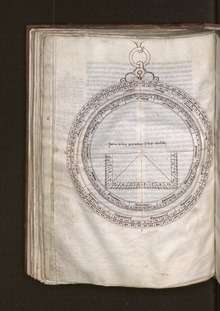
The spherical astrolabe, a variation of both the astrolabe and the armillary sphere, was invented during the Middle Ages by astronomers and inventors in the Islamic world.[lower-alpha 4] The earliest description of the spherical astrolabe dates back to Al-Nayrizi (fl. 892–902). In the 12th century, Sharaf al-Dīn al-Tūsī invented the linear astrolabe, sometimes called the "staff of al-Tusi," which was "a simple wooden rod with graduated markings but without sights. It was furnished with a plumb line and a double chord for making angular measurements and bore a perforated pointer."[19] The first geared mechanical astrolabe was later invented by Abi Bakr of Isfahan in 1235.[20]
Peter of Maricourt, in the last half of the 13th century, also wrote a treatise on the construction and use of a universal astrolabe (Nova compositio astrolabii particularis). Universal astrolabes can be found at the History of Science Museum in Oxford.
The English author Geoffrey Chaucer (ca. 1343–1400) compiled a treatise on the astrolabe for his son, mainly based on Messahalla. The same source was translated by the French astronomer and astrologer Pélerin de Prusse and others. The first printed book on the astrolabe was Composition and Use of Astrolabe by Christian of Prachatice, also using Messahalla, but relatively original.
In 1370, the first Indian treatise on the astrolabe was written by the Jain astronomer Mahendra Suri.[21]
The first known metal astrolabe in Western Europe is the Destombes astrolabe made from brass in tenth-century Spain.[22][23] Metal astrolabes avoided the warping that large wooden astrolabes were prone to, allowing the construction of larger and therefore more accurate instruments; however, metal astrolabes were also heavier than wooden instruments of the same size, making it difficult to use them as navigational instruments.[24] The astrolabe was almost certainly first brought north of the Pyrenees by Gerbert of Aurillac (future Pope Sylvester II), where it was integrated into the quadrivium at the school in Reims, France, sometime before the turn of the 11th century.[25] In the 15th century, the French instrument-maker Jean Fusoris (ca. 1365–1436) also started remaking and selling astrolabes in his shop in Paris, along with portable sundials and other popular scientific gadgets of the day. Thirteen of his astrolabes survive to this day.[26] Finally, one more special example of craftsmanship in the early 15th-century Europe is the astrolabe dated 1420, designed by Antonius de Pacento and made by Dominicus de Lanzano.[27]
In the 16th century, Johannes Stöffler published Elucidatio fabricae ususque astrolabii, a manual of the construction and use of the astrolabe. Four identical 16th-century astrolabes made by Georg Hartmann provide some of the earliest evidence for batch production by division of labor.
Astrolabes and clocks
At first mechanical astronomical clocks were influenced by the astrolabe; in many ways they could be seen as clockwork astrolabes designed to produce a continual display of the current position of the sun, stars, and planets. For example, Richard of Wallingford's clock (c. 1330) consisted essentially of a star map rotating behind a fixed rete, similar to that of an astrolabe.[28]
Many astronomical clocks, such as the famous clock at Prague, use an astrolabe-style display, adopting a stereographic projection (see below) of the ecliptic plane.
In recent times, astrolabe watches have become a feature of haute horologie. For example, in 1985 Swiss watchmaker Dr. Ludwig Oechslin designed and built an astrolabe wristwatch in conjunction with Ulysse Nardin. Dutch watchmaker Christaan van der Klauuw also manufactures astrolabe watches today.
Construction

An astrolabe consists of a disk, called the mater (mother), which is deep enough to hold one or more flat plates called tympans, or climates. A tympan is made for a specific latitude and is engraved with a stereographic projection of circles denoting azimuth and altitude and representing the portion of the celestial sphere above the local horizon. The rim of the mater is typically graduated into hours of time, degrees of arc, or both. Above the mater and tympan, the rete, a framework bearing a projection of the ecliptic plane and several pointers indicating the positions of the brightest stars, is free to rotate. These pointers are often just simple points, but depending on the skill of the craftsman can be very elaborate and artistic. There are examples of astrolabes with artistic pointers in the shape of balls, stars, snakes, hands, dogs' heads, and leaves, among others.[29] The names of the indicated stars were often engraved on the pointers in Arabic or Latin.[30] Some astrolabes have a narrow rule or label which rotates over the rete, and may be marked with a scale of declinations.
The rete, representing the sky, functions as a star chart. When it is rotated, the stars and the ecliptic move over the projection of the coordinates on the tympan. One complete rotation corresponds to the passage of a day. The astrolabe is therefore a predecessor of the modern planisphere.
On the back of the mater there is often engraved a number of scales that are useful in the astrolabe's various applications; these vary from designer to designer, but might include curves for time conversions, a calendar for converting the day of the month to the sun's position on the ecliptic, trigonometric scales, and a graduation of 360 degrees around the back edge. The alidade is attached to the back face. An alidade can be seen in the lower right illustration of the Persian astrolabe above. When the astrolabe is held vertically, the alidade can be rotated and the sun or a star sighted along its length, so that its altitude in degrees can be read ("taken") from the graduated edge of the astrolabe; hence the word's Greek roots: "astron" (ἄστρον) = star + "lab-" (λαβ-) = to take.
See also
- Antikythera mechanism
- Armillary sphere
- Astrarium
- Astronomical clock
- Canterbury Astrolabe Quadrant
- Cosmolabe
- Equatorium
- Hypatia
- Islamic astronomy
- Marshall Islands stick chart
- Nocturnal
- Orrery
- Philippe Danfrie, designer and maker of mathematical instruments, globes and astrolabes
- Planetarium
- Planisphere
- Prague Orloj
- Sextant (astronomical)
- Sharafeddin Tusi, the inventor of the linear astrolabe
- Torquetum
References
- Footnotes
- ↑ "The astrolabe was in fact an invention of the ancient Greeks."[9]
"It is generally accepted that Greek astrologers, in either the first or second centuries BC, invented the astrolabe, an instrument that measures the altitude of stars and planets above the horizon. Some historians attribute its invention to Hipparchus, while others note that Synesius, a student of Hypatia, credits her for the invention in his letters."[10] - ↑ Modern editions of John Philoponus' treatise on the astrolabe are De usu astrolabii eiusque constructione libellus (On the Use and Construction of the Astrolabe), ed. Heinrich Hase, Bonn: E. Weber, 1839, OCLC 165707441 (or id. Rheinisches Museum für Philologie 6 (1839): 127–71); repr. and translated into French by Alain Philippe Segonds, Jean Philopon, traité de l'astrolabe, Paris: Librairie Alain Brieux, 1981, OCLC 10467740; and translated into English by H.W. Green in R.T. Gunther, The Astrolabes of the World, Vol. 1/2, Oxford, 1932, OL 18840299M repr. London: Holland Press, 1976, OL 14132393M pp. 61–81.
- ↑ O'Leary, De Lacy (1948). How Greek Science passed to the Arabs. Routledge and Kegan Paul. "The most distinguished Syriac scholar of this later period was Severus Sebokht (d. 666–7), Bishop of Kennesrin. [...] In addition to these works [...] he also wrote on astronomical subjects (Brit. Mus. Add. 14538), and composed a treatise on the astronomical instrument known as the astrolabe, which has been edited and published by F. Nau (Paris, 1899)."
Severus' treatise was translated by Jessie Payne Smith Margoliouth in R.T. Gunther, Astrolabes of the World, Oxford, 1932, pp. 82–103. - ↑ Emilie Savage-Smith (1993). "Book Reviews", Journal of Islamic Studies 4 (2), pp. 296–299. doi:10.1093/jis/4.2.296
"There is no evidence for the Hellenistic origin of the spherical astrolabe, but rather evidence so far available suggests that it may have been an early but distinctly Islamic development with no Greek antecedents."
- Notes
- 1 2 astrolabe, Oxford English Dictionary 2nd ed. 1989
- ↑ In the Islamic world, it was used to navigate deserts, then oceans, and to calculate the direction to Mecca.
- ↑ Astrolabe, on Oxford Dictionaries
- ↑ "Online Etymology Dictionary". Etymonline.com. Retrieved 2013-11-07.
- 1 2 King 1981, p. 44.
- ↑ King 1981, p. 51.
- ↑ King 1981, p. 45.
- ↑ Lewis 2001.
- ↑ Evans 1998, p. 155.
- ↑ Krebs & Krebs 2003, p. 56.
- ↑ Michael Deakin (August 3, 1997). "Ockham's Razor: Hypatia of Alexandria". ABC Radio. Retrieved July 10, 2014.
- ↑ Sebokht, Severus. "Description of the astrolabe". Tertullian.org.
- ↑ See p. 289 of Martin, L. C. (1923), "Surveying and navigational instruments from the historical standpoint", Transactions of the Optical Society, 24 (5): 289–303, Bibcode:1923TrOS...24..289M, doi:10.1088/1475-4878/24/5/302, ISSN 1475-4878.
- ↑ Victor J. Katz & Annette Imhausen (2007), The Mathematics of Egypt, Mesopotamia, China, India, and Islam: a Sourcebook, Princeton University Press, p. 519, ISBN 0-691-11485-4
- ↑ Richard Nelson Frye: Golden Age of Persia. p. 163
- ↑ "The Earliest Surviving Dated Astrolabe". HistoryOfInformation.com.
- ↑ Dr. Emily Winterburn (National Maritime Museum), Using an Astrolabe, Foundation for Science Technology and Civilisation, 2005.
- ↑ Lachièz-Rey, Marc; Luminet, Jean-Pierre (2001). Celestial Treasury: From the Music of Spheres to the Conquest of Space. Trans. Joe Laredo. Cambridge, UK: Cambridge University Press. p. 74. ISBN 978-0-521-80040-2.
- ↑ O'Connor, John J.; Robertson, Edmund F., "Sharaf al-Din al-Muzaffar al-Tusi", MacTutor History of Mathematics archive, University of St Andrews.
- ↑ Bedini, Silvio A.; Maddison, Francis R. (1966). "Mechanical Universe: The Astrarium of Giovanni de' Dondi". Transactions of the American Philosophical Society. 56 (5): 1–69. doi:10.2307/1006002. JSTOR 1006002.
- ↑ Glick, Thomas; et al., eds. (2005), Medieval Science, Technology, and Medicine: An Encyclopedia, Routledge, p. 464, ISBN 0-415-96930-1
- ↑ "Qantara – 'Carolingian' astrolabe". Qantara-med.org. Retrieved 2013-11-07.
- ↑ Nancy Marie Brown (2010), "The Abacus and the Cross". Page 140. Basic Books. ISBN 978-0-465-00950-3
- ↑ Boyle, David (2011). Toward the Setting Sun: Columbus, Cabot, Vespucci, and the Race for America. Bloomsbury Publishing USA. p. 253. ISBN 9780802779786..
- ↑ Nancy Marie Brown (2010), "The Abacus and the Cross". Page 143. basic Books. ISBN 978-0-465-00950-3
- ↑ Hockey, Thomas (2009). The Biographical Encyclopedia of Astronomers. Springer Publishing. ISBN 978-0-387-31022-0. Retrieved August 22, 2012.
- ↑ Ralf Kern (2010), Wissenschaftliche Instrumente in ihrer Zeit. Band 1: Vom Astrolab zum mathematischen Besteck. Cologne, S. 204. ISBN 978-3-86560-865-9
- ↑ North 2005.
- ↑ Stephenson, Bruce; Bolt, Marvin; Friedman, Anna Felicity (2000). The Universe Unveiled: Instruments and Images through History. Cambridge, UK: Cambridge University Press. pp. 108–109. ISBN 0-521-79143-X.
- ↑ "Star Names on Astrolabes". Ian Ridpath. Retrieved 2016-11-12.
- Bibliography
- Evans, James (1998), The History and Practice of Ancient Astronomy, Oxford University Press, ISBN 0-19-509539-1.
- Gunella, Alessandro; Lamprey, John (2007), Stoeffler's Elucidatio (translation of Elucidatio fabricae ususque astrolabii into English), John Lamprey
- Krebs, Robert E.; Krebs, Carolyn A. (2003), Groundbreaking Scientific Experiments, Inventions, and Discoveries of the Ancient World, Greenwood Press.
- King, D. A (1981), "The Origin of the Astrolabe According to the Medieval Islamic Sources", Journal for the History of Arabic Science, 5: 43–83
- Lewis, M. J. T. (2001), Surveying Instruments of Greece and Rome, Cambridge University Press.
- Morrison, James E (2007), The Astrolabe, Janus, ISBN 978-0-939320-30-1.
- Laird, Edgar (1997), Carol Poster and Richard Utz, ed., "Astrolabes and the Construction of Time in the Late Middle Ages.", Constructions of Time in the Late Middle Ages, Evanston, IL: Northwestern University Press: 51–69
- North, John David (2005), God's Clockmaker: Richard of Wallingford and the Invention of Time, Continuum International Publishing Group, ISBN 978-1-85285-451-5
- Laird, Edgar; Fischer, Robert, eds. (1995), "Critical edition of Pélerin de Prusse on the Astrolabe (translation of Practique de Astralabe", Medieval & Renaissance Texts & Studies, Binghamton, New York, ISBN 0-86698-132-2
- King, Henry (1978), Geared to the Stars: the Evolution of Planetariums, Orreries, and Astronomical Clocks, University of Toronto Press
External links
| Wikimedia Commons has media related to Astrolabe. |
| Wikisource has the text of the 1911 Encyclopædia Britannica article Astrolabe. |
- A digital astrolabe (HTML5 and javascript)
- paper astrolabe generator, from the ESO
- "Hello World!" for the Astrolabe: The First Computer Video of Howard Covitz's Presentation at Ignite Phoenix, June 2009. Slides for Presentation Licensed as Creative Commons by-nc-nd.
- Video of Tom Wujec demonstrating an astrolabe. Taken at TEDGlobal 2009. Includes clickable transcript. Licensed as Creative Commons by-nc-nd.
- The Astrolabe
- A working model of the Dr. Ludwig Oechslin's Astrolabium Galileo Galilei watch
- Ulysse Nardin Astrolabium Galilei Galileo: A Detailed Explanation
- Fully illustrated online catalogue of world's largest collection of astrolabes
- Mobile astrolabe and horologium
- Medieval equal hour horary quadrant
- A Beginner's Guide to Basic Construction and Use of the Astrolabe (using ruler, protractor and compasses).
